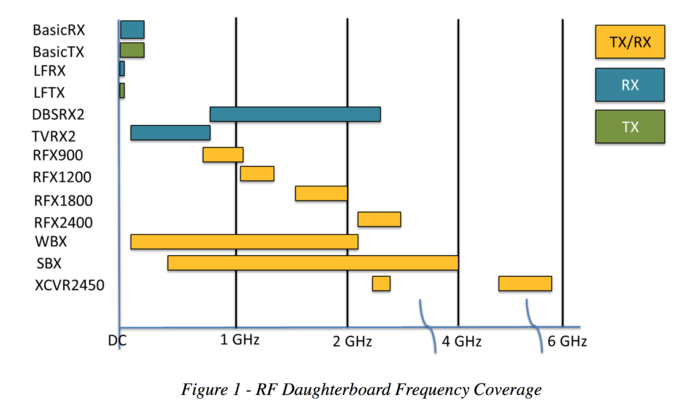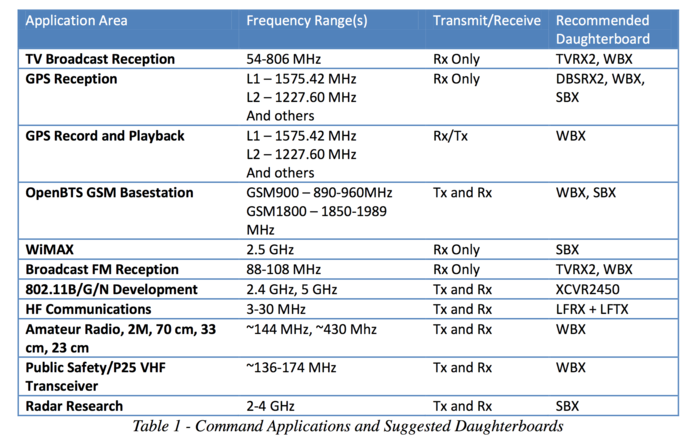Selecting a RF Daughterboard
Contents
- 1 Introduction
- 2 Overview
- 3 What frequency range do I plan to operate within?
- 4 How much bandwidth do I need?
- 5 Am I trying to build a Multiple-In-Multiple-Out (MIMO) system?
- 6 Do I Need Full Duplex Capability?
- 7 Do I plan to implement beamforming or direction finding (DF) capability?
- 8 I plan to operate in the 900 or 1800 MHz bands. Should I use SBX/WBX or an RFX series board?
- 9 Am I using an external front end?
- 10 Conclusion
Introduction
Application Note Number: AN-5501
Authors: John Smith and Jane Smith
Organization: Ettus Research
Last Modified Date: 2016/04/15
Reference: https://www.ettus.com/content/files/kb/Selecting_an_RF_Daughterboard.pdf
Overview
This application note by Ettus ResearchTM helps users select the most appropriate daughterboard for their use of the USRPTM (Universal Software Radio Peripheral) family of software defined radio hardware. RF daughterboard selection is made based on the application requirements for frequency coverage, bandwidth and number of channels. This note is organized in an FAQ style to help identify which RF daughterboard is right for specific applications.
What frequency range do I plan to operate within?
n many cases, the selection of an RF daughterboard is made solely on the application requirements for frequency coverage. For example, GSM applications such as OpenBTS usually use the 900 MHz and 1800 MHz cell phone bands. If the user wants to cover these bands, both the WBX and SBX boards are good candidates. A graphic showing the frequency coverage of the RF daughterboards is shown in Figure 1. Note color codes indicate whether a board includes a transmit chain, receive chain or both.
Many USRP hardware users involved in general experimentation may not have a specific frequency or band of interest. In this case, Ettus Research recommends the WBX or SBX daughterboards, which provide wide frequency coverage.
How much bandwidth do I need?
After selecting a daughterboard based on frequency coverage, users must also ensure the daughterboard can meet the bandwidth requirements for the application(s) of interest. Most of the transceiver daughterboards provide 40 MHz of instantaneous RF bandwidth in both the transmit and receive directions. The ability to utilize the full bandwidth depends on the USRP device the daughterboard is paired with and the resolution of the data transferred over the host interface.
As with frequency coverage, many users are looking to experiment without any specific application in mind. Once again, the WBX and SBX transceiver daughterboards are a good choice because they provide full-duplex capability with bandwidth that is more than sufficient for many applications.
Users interested in receive-only configurations should take note of the DBSRX2, which provides a configurable baseband filter. This filter can be adjusted from 1 MHz to 60 MHz, which allows the user to make trade-offs between selectivity and bandwidth.
One important thing to consider is the bandwidth capability of the USRP device selected. While a daughterboard may provide up to 40 MHz of RF bandwidth the, this does not guarantee the USRP device can transfer an equal bandwidth to the host machine. If a user requires a specific maximum bandwidth, they should ensure both the daughterboard and USRP device meet those requirements. If you are not sure about the capabilities of various USRP devices, see “Selecting a USRP Device” application note in the knowledge base.
Am I trying to build a Multiple-In-Multiple-Out (MIMO) system?
Currently, all of the daughterboards available from Ettus Research accept reference clock(s) from the USRP device. Therefore, all daughterboards can be used for MIMO applications requiring frequency alignment and sample clock alignment. For more information on how to assemble a MIMO system with USRP devices, see the “MIMO and Synchronization” application note in the knowledge base.
Do I Need Full Duplex Capability?
If the application requires full-duplex capability, all transceiver daughterboards except the XCVR2450 are appropriate. For more information on the full-duplex capability of these daughterboards, please reference the application note titled “Front-Ends, Sub-Device Specifications and Antenna Ports.”
Do I plan to implement beamforming or direction finding (DF) capability?
While all daughterboards can be used in a MIMO configuration, this does not necessarily imply there is phase alignment between the RF chains of one or more daughterboards. The BasicRx, BasicTX, LFRX and LFTX are exceptions to this, since they do not include local oscillators that contribute to phase ambiguity between channels.
The Ettus Research SBX daughterboard utilizes an RF PLL that includes a resynchronization feature, which can be used to align the LOs across multiple SBXs, and multiple USRP hardware devices. Using the UHD (USRP Hardware DriverTM), timed SPI commands can drive this re-synchronization feature. At the time of this writing, this feature is not supported in the mainline UHD. However, this feature is planned for release in 2012.
Use of any other daughterboard requires channel-to-channel phase calibration after each PLL re-tune. Therefore, the SBX is the preferred solution for beamforming or DF applications.
I plan to operate in the 900 or 1800 MHz bands. Should I use SBX/WBX or an RFX series board?
Many users often ask about choosing the SBX or WBX daughterboard versus the RFX daughterboard, when the RFX can meet the frequency coverage requirements for the application in question. In general, the SBX and WBX provide better performance, particularly when it comes to noise figure (NF). The typical NF of SBX/WBX is 5 dB, versus 8 dB for the RFX series. IP3 is also improved. The WBX and SBX provide power control with variable attenuators.
The ISM band filters present on the TX/RX port of the RFX900 and RFX2400 boards may make them ideal for use in those particular bands, as these specifications increase selectivity and reduce spurious emissions. Aside from this scenario, the SBX and WBX outperform a daughterboard from the RFX series.
Am I using an external front end?
Some USRP radio users elect to use an external front end providing upconversion, downconversion, amplification and filtering functionality. In these cases, the frontend often outputs an intermediate frequency (IF). It is also possible for the frontend to provide an analog, quadrature interface. In either case the BasicRX/BasicTX and LFRX/LFTX daughterboards are good candidates, as they provide a unity gain interface to the ADC(s) and DAC(s) of the USRP hardware.
These boards can also be used without a complete frontend, but external amplifiers and filters may be required to improve noise figure (NF) and inter-modulation performance.
Conclusion
This application note has provided guidance on considerations for selecting a daughterboard to use with the Ettus Research USRP. Using this guide, users should be able to choose an appropriate RF daughterboard for their specific application. If you have any questions regarding this information, please contact [email protected].



